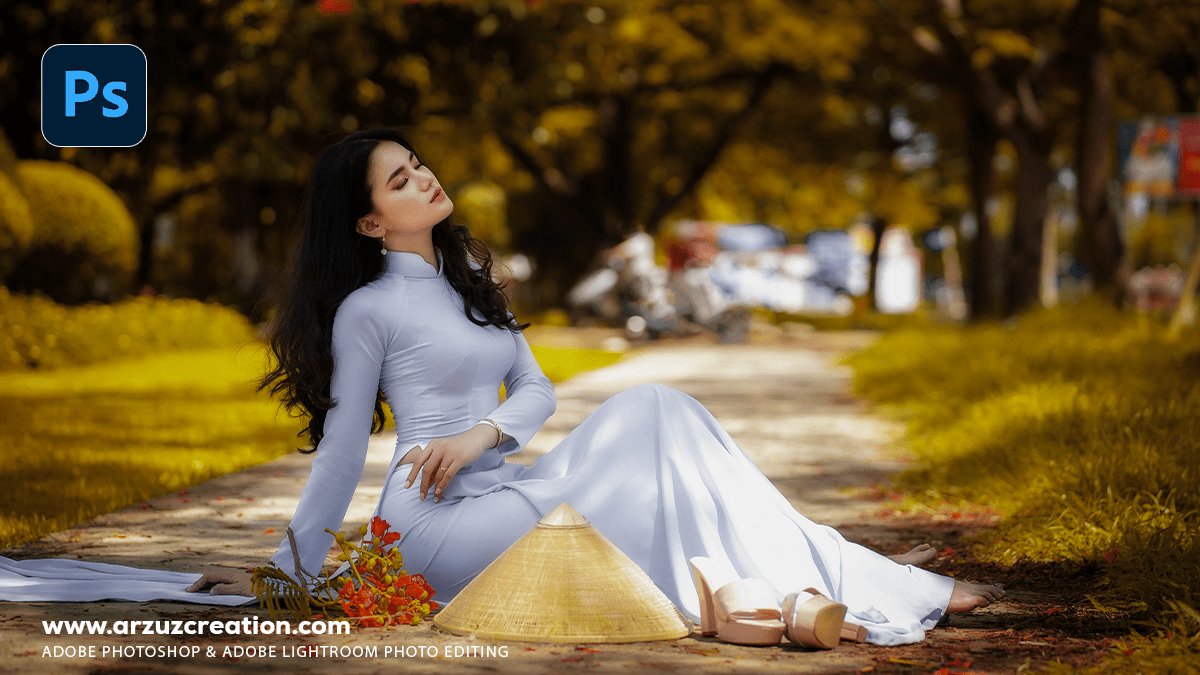Adobe Photoshop: Portrait Photo Colour Grading,
Therefore, when color grading a portrait photo, the goal is to enhance the subject’s features, evoke a specific mood, and create a visually appealing image. In other words, here’s a breakdown of the key steps and techniques involved, often used by professional retouchers and photographers:

1. Initial Adjustments and White Balance:
Therefore, before you get into creative color grading, you need to establish a solid foundation.
- White Balance: This is the most crucial first step. Ensure your whites are neutral and your skin tones are accurate. A slightly warm or cool cast can be part of your creative vision, but it should be a deliberate choice, not a mistake. You can adjust the white balance using a dedicated slider or by using an eyedropper tool on a neutral gray or white area in the photo.
- Exposure: Make sure the overall brightness is correct. Adjust the shadows, midtones, and highlights to bring out detail. Be careful not to blow out highlights or completely crush shadows.
- Contrast: Adjust the overall contrast to give the image punch. You can use the contrast slider or the Tone Curve for more precise control.
2. Skin Tone Correction and Enhancement:
Therefore, this is often the most important part of portrait color grading.
- Hue/Saturation: Is the skin too red, yellow, or magenta? Use the HSL (Hue, Saturation, Luminance) panel to adjust the hue of the red and orange channels. You can also desaturate or saturate these channels slightly to perfect the skin tone.
- Luminance: Adjusting the luminance of the orange and red channels can brighten or darken the skin, which can be useful for evening out skin tones.
- Color Uniformity: Use tools like a selective color adjustment layer in Photoshop to make the skin tones more uniform. For instance, you can selectively add or subtract magenta from the red channel to neutralize any blotchy areas.
3. The “Look” – Creative Color Grading:
Therefore, this is where you apply your creative vision to create a mood. Here are some common looks:
a. Warm and Golden Tones:
- Mood: Happy, romantic, nostalgic, warm, inviting.
- Technique:
- However, slightly shift the overall color temperature to the warmer side.
- In addition, add yellow or orange to the shadows and midtones using a Color Grading tool or Split Toning.
- However, slightly increase the saturation of the red and orange channels.
- In addition, reduce the saturation of blues and greens to make the subject pop against the background.
- However, use a curves adjustment to add a “S-curve” for contrast, or a “matte” look by lifting the black point.
Adobe Photoshop: Portrait Photo Colour Grading,
b. Cool and Moody Tones:
- Mood: Serious, dramatic, cinematic, calm, melancholic.
- Technique:
- In other words, shift the white balance towards the cool side (blues).
- However, add blue or cyan to the shadows using Color Grading or Split Toning.
- In other words, desaturate the reds and yellows to mute the skin tones slightly, but be careful not to make the subject look sickly.
- However, A subtle split tone with blue in the shadows and a hint of orange in the highlights can create a popular “teal and orange” look.
c. Vintage and Film Look:
- Mood: Retro, nostalgic, authentic, timeless.
- Technique:
- Matte look: Lift the black point in the Tone Curve (Curves adjustment) to create a faded, less contrasty look.
- Split Toning: Add a subtle color cast to the shadows and highlights (e.g., green or cyan in shadows, yellow or red in highlights).
- Grain: Add a film grain effect. This can be done with dedicated filters or by adding a layer of noise in Photoshop.
- Desaturation: Slightly desaturate the overall image.
Adobe Photoshop: Portrait Photo Colour Grading,

d. High-Key (Bright and Airy)
- Mood: Light, clean, ethereal, dreamy.
- Technique:
- In other words, increase the overall exposure, especially in the midtones and highlights.
- However, use a Curves adjustment to create a gentle, open curve, lifting the midtones without blowing out the highlights.
- In other words, keep the colors slightly desaturated and bright, focusing on pastels.
- However, ensure the skin tones remain natural and not overly bright or washed out.
4. Selective Adjustments and Final Touches:
- Vignette: A subtle vignette can help draw the viewer’s eye to the subject’s face. You can use a radial filter or a dedicated vignette tool.
- Color Isolation: If you want your subject to pop, you can selectively desaturate or change the hue of the background. For example, if your subject is wearing a red shirt, you can change the green background to a more muted color to make the red stand out.
- Sharpening: Apply a final sharpening pass to the details of the face (eyes, lips) to make them crisp. Use a mask to apply sharpening only where needed.
Adobe Photoshop: Portrait Photo Colour Grading,
Popular Tools for Color Grading:
- Adobe Lightroom: Excellent for initial adjustments, color grading tools, and presets.
- Adobe Photoshop: Offers more precise control with adjustment layers, masks, and advanced tools for selective color grading.
- Capture One: Known for its superior color handling and tethering capabilities.
- Third-party plugins: Plugins like Exposure X7, Luminar Neo, and Alien Skin offer a wide range of presets and film simulations.
Remember, the best color grade is one that supports the emotion and story of the photograph without distracting from the subject. It’s often about balance and subtlety.
